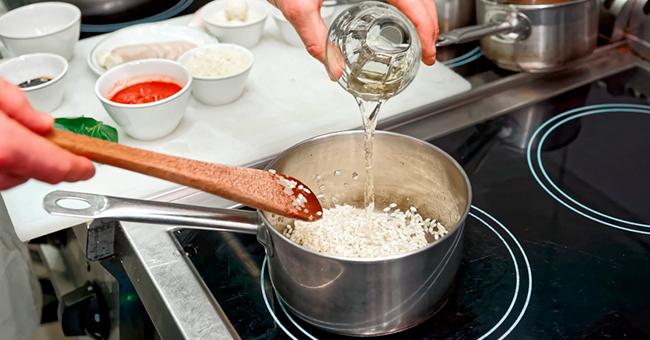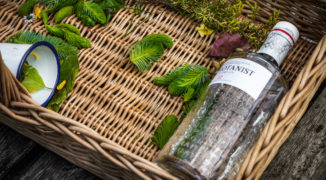We’ve learned from a week of investigating vermouth that there are a few basic rules to preserving the aperitif and selling it at optimal quality: unopened vermouth should stay out of the sun (and bright light, in general) and away from heat, and once the vermouth is opened, it belongs in the fridge. Once the bottle’s been popped, vermouth has about six to eight weeks before its flavor begins to turn as oxidation takes its toll. But if an open bottle of vermouth has fallen victim to time and neglect, do not despair! There’s no reason to pour that inventory down the sink, or worse, drink it after it’s become oxidized past its prime. We talked to two barmen known for curbing waste by innovating sustainable (and edible) solutions about how to make use of oxidized vermouth.
For Todd Maul of Boston’s Cafe ArtScience, oxidized vermouth can become a medium for art. “What you’re actually able to do is you can pull it through a rotational evaporator and make it into a tincture and then into a paint,” Maul says. This paint has been used up the side of a glass, and when that glass is filled with a cocktail, the paint contributes not only a stunning visual element, but also vermouth flavor notes.
And that’s not Maul’s exclusive artistic interpretation. “We took some of the other vermouth that was a little bit … past its date,” he says. “And we made it into what we call waft caps — it’s sugar, Carpano vermouth that we basically heat up and then make into this very fragile almost like glass. Then we smash it. Then we grind it up, and we make it into a very fine powder. And then we bake it and so we make it into a cap, which holds this vapor in and then you break it and it falls into the drink, and then it’s part of the drink.”
Maul’s use of oxidized vermouth is elaborate, and that’s part of the glory — taking something that would be deemed refuse by many and creating something elegant and exceptionally creative. And often, these drinks are interactive for the guest, as in the case of the Bit Final cocktail.
“We take Carpano vermouth and then we freeze it, we take a half ounce and we freeze it on the bottom of the rocks glass in a blast freezer and then we take it out and we pour a quarter ounce of sherry on top of that and then we freeze it,” he says. “And then we actually make the drink and pour it over top of that base frozen, and then as you’re drinking the drink and your hand warms up the base of the drink, it breaks off at the bottom, floats to the top and then dissolves and changes the flavor of the drink.”
The use of oxidized vermouth at Cafe ArtScience is exemplary of a larger philosophy in play, one that involves thinking outside of the box.
“What we’re trying to do is really utilize everything and then utilize it in a very creative way so that you’re getting a very cool experience, and we’re trying to repurpose everything that we’re doing and using,” Maul says.
At Betony in New York City, general manager Eamon Rockey makes an equally conscientious use of oxidized vermouth.
“The best way I know of to utilize vermouth that’s no longer tasty in a drink is to cook with it,” Rockey says. Because it’s often based on wine, “it works great in a cooking context because you’re heating it up, you’re exposing it to a lot of oxygen, you’re usually reducing it, etc. and you’re burning off all of the alcohol. So all of the processes that are making the wine and or vermouth unusable in a cocktail are actually going to be exacted on that wine or vermouth to a much more intense degree if you’re cooking with it. And that typically ends up working quite well.”
Rockey recommends using dry vermouths in a deglazing capacity, like in searing shrimp or something similar. He finds sweet vermouths work best in stews and heartier foods.
“I definitely highly recommend people feeling comfortable using vermouth in lieu of or in addition to wines in application,” says Eamon.
But vermouth isn’t exclusively delicious in foods that you mean to eat immediately, it’s also great for preserving foods.
“For instance, at Betony we make our own brandied cherries and we preserve all sorts of different fruits and veggies and even vermouth that is a bit oxidized or is maderized if it’s been stored to close to heat, it works really really well to preserve cherries … and/or other fruits, you don’t just have to limit it to cherries,” he says.
So before you ditch that bottle of vermouth that has slipped past its glory days, try experimenting with these inventive alternative uses.





